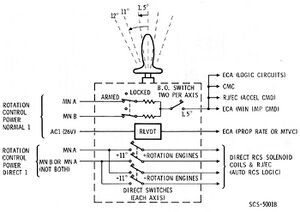Rotation Hand Controller: Difference between revisions
imported>Tschachim (Work in progress...) |
imported>Tschachim (Work in progress...) |
||
| Line 2: | Line 2: | ||
== RHC commands == | == RHC commands == | ||
[[Image:RHC_diagram.jpg|thumb|right|The command switches of the RHC<cite>AOH</cite>]] | |||
The axes of the real RHC are the same as the axes of a joystick, so if a joystick is configured it can be used as usual. In case of Orbiter's attitude controls they are used as configured in Orbiter. Within the RHC there are three command sources per axis: | The axes of the real RHC are the same as the axes of a joystick, so if a joystick is configured it can be used as usual. In case of Orbiter's attitude controls they are used as configured in Orbiter. Within the RHC there are three command sources per axis: | ||
| Line 13: | Line 15: | ||
When a digital control like a keyboard is used as RHC input, an attitude command is simulated as full deflection, i.e. both the brakeout and the direct switches are closed and the transducers produce full signal strength. | When a digital control like a keyboard is used as RHC input, an attitude command is simulated as full deflection, i.e. both the brakeout and the direct switches are closed and the transducers produce full signal strength. | ||
<biblio force=false> | |||
#I The TRANS CONTR PWR switch receives power from the SCS CONTR/AUTO MNA/B circuit breakers on panel 8 | |||
#[[References]] | |||
</biblio> | |||
Revision as of 23:21, 3 June 2008
The Rotation Hand Controller (RHC) provides the capability of manual control of spacecraft rotation in either direction about each axis. Also the RHC may be used for manual thrust vector control (see SPS). In the real CSM there were two identical Rotation Hand Controllers, in Project Apollo - NASSP both are simulated simultaneously by using one joystick or Orbiter's attitude controls (joystick, keyboard) when configured with the Launchpad Configuration Options.
RHC commands

The axes of the real RHC are the same as the axes of a joystick, so if a joystick is configured it can be used as usual. In case of Orbiter's attitude controls they are used as configured in Orbiter. Within the RHC there are three command sources per axis:
- Breakout Switches - A switch closure occurs whenever the RHC is moved 1.5° from its null position (about 12% of total deflection). Separate switches are provided in each axis and for each direction of rotation. These six breakout switches are used to provide: command signals to the CMC, SCS minimum impulse and acceleration commands, BMAG cage signals and proportional rate command enabling.
- Transducers - Transducers produce AC signals proportional to the RHC displacement from the null position. These signals are used to command spacecraft rotation rates during SCS proportional rate mode and to command SPS engine gimbal position during Manual Thrust Vector Control (MTVC).
- Direct Switches - Direct switches will close whenever the RHC is moved a nominal 11.5° from its null position (about 92% of total deflection). Direct switch closure will produce acceleration commands through the RCS direct solenoids.
When a digital control like a keyboard is used as RHC input, an attitude command is simulated as full deflection, i.e. both the brakeout and the direct switches are closed and the transducers produce full signal strength.
<biblio force=false>
#I The TRANS CONTR PWR switch receives power from the SCS CONTR/AUTO MNA/B circuit breakers on panel 8 #References
</biblio>